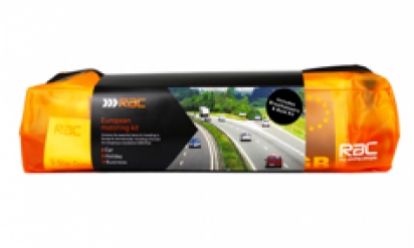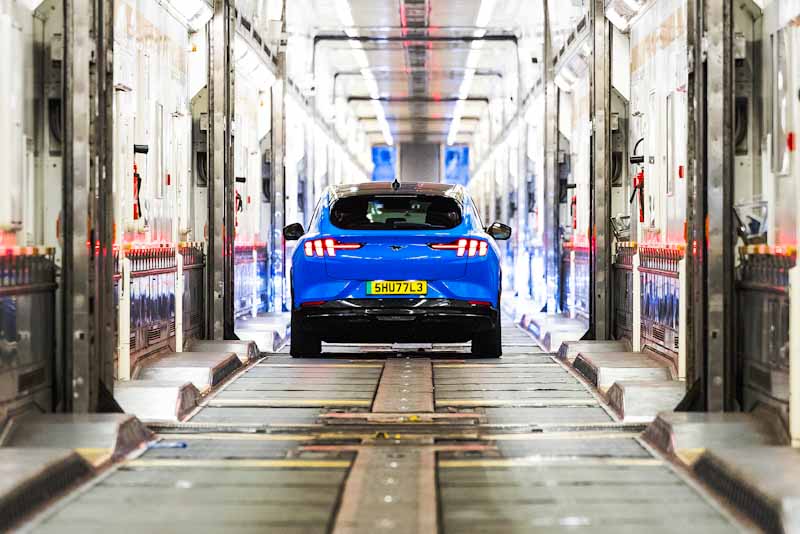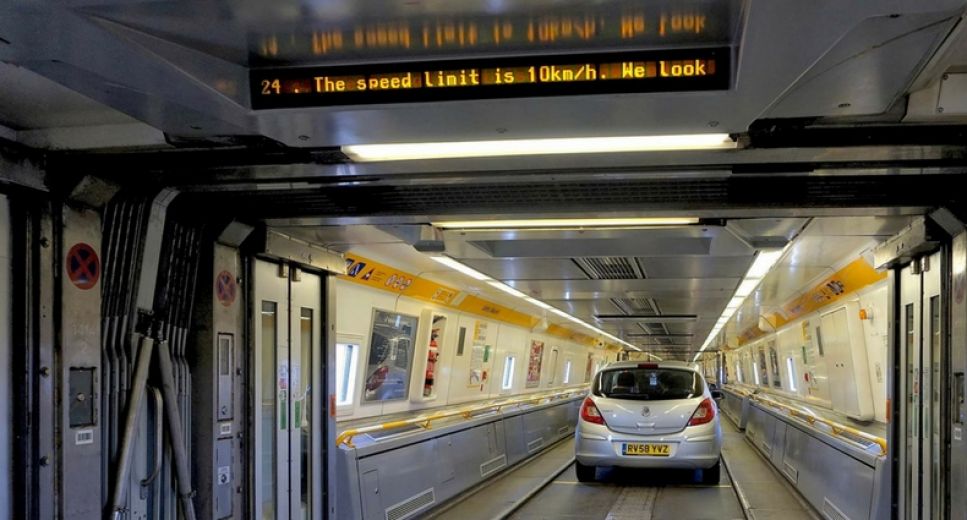Whether you are planning a weekend in France or a European road trip, it's important to be prepared for your journey. That is why we've put together a complete guide to the Channel Tunnel to make your journey from Folkstone to Calais as smooth as possible.
So, from booking your ticket to boarding LeShuttle (formerly known as Eurotunnel Le Shuttle), let us to guide you through everything you need to know about taking a car, van or campervan to France through the Channel Tunnel.
Can I drive my car through the Channel Tunnel?
No, you cannot drive your car through the Channel Tunnel. Instead, you must board the LeShuttle service with your vehicle, which boards at the Channel Tunnel terminals in Folkestone and Calais.
Once you have driven your vehicle on to the carriage, parked and switched off your engine, the LeShuttle service will whisk you from Folkestone to Calais in just 35 minutes.
What should I take with me in my car when using the Channel Tunnel/LeShuttle?
All passengers (including pets) will need a valid passport or ID card. You will also need your ticket hanger, which will be given to you at the check-in booths.
You’ll be disembarking the train on French soil, so make sure you are carrying the items required by law when driving in France.
These include: reflective jackets, warning triangle, headlamp beam deflectors, UK sticker and a spare bulb kit. You can purchase a European driving kit with the RAC.
Do I need insurance and breakdown cover to use the Channel Tunnel/LeShuttle?
You are advised to arrange European breakdown cover and check your insurance covers you for driving abroad, before travelling.
Check your car insurance policy documents to see if you have the minimum compulsory cover required to drive in other European countries. Most car insurance policies will give you the cover you need to take your car to EU countries, but you may not have the same level of protection as you have in the UK.
You should also check with your insurance provider that you’re covered for cancelled or delayed departures through the Channel Tunnel, emergency accommodation, car hire and roadside assistance.
RAC European Breakdown Cover provides a recovery service in 48 different countries. If you're just planning a short trip to Europe, then our single trip option may be for you.
What items can’t I take in my car when crossing the channel with LeShuttle?
Vehicles powered by LPG (Liquefied Petroleum Gas) cannot be transported by LeShuttle, even if it is being used as a secondary fuel source.
Firearms are not permitted for carriage unless accompanied by a valid Firearms or Shotgun Certificate(s), and all firearms must be declared at check-in.
Fireworks are also prohibited.
For prohibited and restricted items when entering France, consult the relevant documents.
For example, excise duties and taxes are payable in France if alcoholic beverage and tobacco purchases were made for commercial purposes, i.e. not for personal consumption.
Driving in France Kit from £25.99
Did you know you could be fined up to €530 for not carrying the right kit with you in France?


Can I tow a trailer and use the Channel Tunnel/LeShuttle?
Towing trailers is permitted and you will be allocated space in one of LeShuttle’s single deck carriages. These are twice as high as the double-deck carriages and the entrances are wider, making it easier to manoeuvre a trailer.
Can I take an EV on LeShuttle?
Yes, you can take an electric car, plug-in hybrid, and self-charging hybrid vehicles on LeShuttle. The only restrictions in place are for LPG vehicles.
EV charging at LeShuttle
Electric car drivers can take advantage of the charging points at both the Folkestone and Calais terminals at LeShuttle.
At the Folkestone terminal, there are four 210kW ultra rapid chargers, and at the Calais terminal, there are eight 210kW ultra rapid chargers.
Dedicated Tesla Superchargers are also available at the terminal buildings on both sides of the Channel.
Do I need to check in to use LeShuttle? And if so, how long before my departure time?
You should check-in at least 60 minutes before your scheduled departure time, but no more than two hours before travel. If you are travelling with pets, you will need to arrive up to two hours before departure.
If you have made an advanced booking, you can use the self check-in lanes, sign-posted by the self check-in pictogram. Simply insert the payment card used to make the booking and follow the instructions on the display. If you don’t have access to the payment card, or the booking was made by a business or travel agent, simply use your reference number.
Alternatively, use the manual check-in kiosks, where an operator will deal with your check-in and provide your ticket hanger.
How much does LeShuttle cost?
Prices vary depending on size of car, time of travel and the type of ticket. All fares include a car and up to nine passengers and there are no charges for excess luggage.
As a quick overview, here are some prices you can expect to pay (correct for February 2025):
- Day trip and overnight (travel up until 30/03/25): from £59
- Short stay saver (5 days or less): from £96
- Standard (any duration): from £118
- Standard refundable (any duration): from £158
- Short stay Flexiplus (five days or less): £214
- Flexiplus (any duration): from £274
All prices are per car and each way.
Flexiplus is by far the most relaxing and flexible way to cross the Channel. You can turn up at any time and board the next available train, at which point you’ll be given priority boarding. You will also be among the first to disembark once through the Channel Tunnel.
A Flexiplus ticket also includes a dedicated check-in facility, use of an exclusive lounge, complimentary refreshments, magazines and newspapers. Lounges facilities are open 6am until 10pm daily.
Do you have to stay in your car when using LeShuttle?
You can choose to sit in the car during the entire crossing, or get out and stretch your legs on the train. There are toilets available, should you need them.
How long does it take to travel through the Channel Tunnel?
The crossing takes 35 minutes, making it the fastest way to travel across the English Channel.
What are my LeShuttle luggage allowances?
There are no luggage restrictions on LeShuttle, so you can pack as much as you can safely fit in the car for a European road trip.
Where do I get on LeShuttle in the UK?
The UK LeShuttle terminal at the Channel Tunnel is at Folkstone It is reached via the M25 and M20. Exit the motorway at Junction 11a and head straight to the check-in booths. You will need your booking reference number and the credit or debit card used at the time of booking.
You will be given a departure hanger for your windscreen and you will have time to visit the passenger terminal before departure. When ready, head to passport control, before boarding commences approximately 25 minutes before your departure time. Simply follow the green arrows to your allocated lane.
The process is the same on the French side, with the Channel Tunnel accessed via the A16 motorway near Calais. Exit at Junction 42 and follow the signs for “Tunnel sous la Manche”.
How do I book tickets for LeShuttle?
Tickets may be booked online via the LeShuttle website or LeShutte App. Alternatively, you can telephone to make a reservation. Phone lines are open 8am to 7pm Monday to Friday, 8pm to 5.30pm Saturday and 9am to 5.30pm Sunday.


Instant cover available
• 24/7 rescue at the roadside
• Help to get home if your vehicle can't be fixed
• 5 star Defaqto rated cover

What are the LeShuttle rules for other vehicle types?
LeShuttle rules for vans
LeShuttle allocates space in the single deck carriages for vehicles higher than 1.85 metres. Vans with an AGW (Actual Gross Weight) up to 3.5 tonnes carrying commercial goods may travel on the passenger service but must be booked through a dedicated account.
Vans are divided into the following categories:
- Low Van (under 1.85 metres): used for private, tourist or leisure travel only. Maximum weight is 3.5 tonnes.
- High Van (over 1.85 metres): used for private, tourist or leisure travel only. Maximum weight is 3.5 tonnes.
- Campervan: any vehicle which includes living accommodation, including seats, table, sleeping, cooking and storage facilities.
LeShuttle rules for caravans, campervans & trailers
Space will be allocated in the single deck carriages, which are twice as high as the double-deck carriages and feature wider entrance and exit points.
LPG or equivalent flammable gas tanks cannot be transported even if empty or the LPG or equivalent flammable gas mode of the vehicle is not selected.
Domestic flammable gas containers are allowed with the following restrictions:
- Portable containers (cylinders/bottles, etc): Maximum of 47kg per cylinder and no more than 50kg per vehicle if more than 1 container
- Fixed containers (tanks): Maximum of 47kg per container and no more than 50kg per vehicle if more than 1 container
- Fixed containers must be no more than 80% full. The capacity of the container will be checked by staff
LeShuttle rules for motorcycles
Tickets are available each way, which includes the motorcycle, rider and pillion. You stay with your motorcycle for the entire crossing and no strapping is necessary.
LeShuttle rules for coaches
Coach operators interested in booking travel through the Channel Tunnel are advised to contact LeShuttle.
Taking your pets on LeShuttle
Since 2000, LeShuttle has carried more than four million UK pet journeys from the UK to France.
When taking a pet to France, traveling with LeShuttle means the whole family can stay together during the crossing from Folkestone to Calais.
However, before setting off, it's important to check the requirements for traveling with a pet (this can vary depending on the species).
A handy checklist is provided by LeShuttle when you place your booking to help with the preparations. Both terminals offer 24-hour pet check-in, and they should be checked in at least 1 hour (and no more than 2 hours) before the departure time.
A booking reference should be brought along for the pet and kept with you at all times.
The Pet Reception in the terminal building will handle the final checks needed for travel. The terminals also offer dedicated exercise for pets and their owners. Once checked in pets can enjoy a dedicated 'pets playground' to take a moment to stretch and socialize, located just outside the terminal building. LeShuttle also has an indoor pets lounge to relax with treats and water.
If you are travelling with your pets abroad, make sure to check for more details on the LeShuttle website.
LeShuttle journey
What facilities are there on the LeShuttle?
A number of shops and restaurants are available at the LeShuttle terminal, including Starbucks, WH Smith and Burger King. You can also purchase essential items you might require for travelling through Europe.
A click and collect travel money service is available via Travelex and a soft play area is available in Folkestone. Free wifi is available in the passenger terminal buildings and Flexiplus lounges.
Is there a duty free shop at the LeShuttle?
You’ll find a World Duty Free shop in Folkestone and Calais, stocking cosmetics, fragrances, confectionery, wines, spirits and toys. It’s also possible to reserve items online before you travel, ready for collection at the World Duty Free store in Calais.
Items can be reserved between one month and 24 hours before departure. You simply load up your car before boarding the train.
Tips and advice to make your LeShuttle journey smoother
Book early as prices go up nearer the departure time. You’ll be given a reference number and password, giving you the opportunity to change your booking nearer the time. The price might go up, but you won’t be charged a fee for the amendment.
Enter your car’s registration number when making a booking, as the check-in booths feature number plate recognition cameras, which speeds up the entire process.
Make sure you book a double-deck carriage if you have a roof box, a trailer or are carrying bicycles. There’s no extra charge for the added convenience, but do bear in mind that there are fewer double-deck carriages, so departure times might be restricted unless you book early.
For the latest travel information, advice and offers, follow LeShuttle on social media platforms.
- Temporary car insurance - from one hour to 30 days
- Crit’Air clean air stickers – your guide to driving in France
- A guide to French toll roads
What are the advantages of using LeShuttle?
Advantages of using the LeShuttle
Speed of travel is the obvious advantage of using the Channel Tunnel, with a crossing time of just 35 minutes. In contrast, a Dover to Calais ferry will take 90 minutes to cross the English Channel.
There are also up to four departures per hour, while motorway to motorway access makes it quick and easy to continue your journey upon arrival. One ticket covers up to nine passengers and there are no baggage restrictions.
It’s also worth noting that the Folkestone terminal removes 11 miles from the journey to Dover and the service is unlikely to be disrupted by adverse weather conditions. Seasickness won’t be a problem in the Channel Tunnel.

Instant cover available
• 24/7 rescue at the roadside
• Help to get home if your vehicle can't be fixed
• 5 star Defaqto rated cover

Channel Tunnel facts and trivia
The idea of a tunnel connecting Britain with mainland Europe dates back to at least 1802, when French engineer Albert Mathieu proposed an underground highway for horse-drawn carriages. His elaborate proposal included an island in the middle of the English Channel for changing horses.
In the 1980s, leaders from Britain and France invited companies to put forward plans for a connection between the two nations. At this stage a rail tunnel was only one of the ideas on the table. Others included a so-called Eurobridge, featuring suspension bridge with a roadway in an enclosed tube.
Another proposal put forward was for a Euroroute: a 13-mile tunnel between artificial islands approached by bridges at either side. A high-speed rail link was chosen and construction began in 1988. In 1990, a Frenchman and Englishman shook hands through a hole connecting the two tunnel ends.
How was the Channel Tunnel built?
The Channel Tunnel extends to a length of 31.4 miles, with 23.5 miles of tunnel beneath the sea, so it’s little wonder that it represents one of the biggest engineering projects ever undertaken in the UK.
More than 13,000 workers from England and France collaborated on the project, which required 11 tunnel boring machines, many of which were built specifically for the tunnel.
How long did it take to build the Channel Tunnel?
It took more than five years to complete the Channel Tunnel, with construction starting in 1988, before the first car-carrying shuttle crossed the English Channel in 1994.
Who owns the Channel Tunnel?
The Channel Tunnel is operated by LeShuttle, which also operates the trains, along with Eurostar and DB Schenker Rail.

Instant cover available
• 24/7 rescue at the roadside
• Help to get home if your vehicle can't be fixed
• 5 Star Defaqto rated cover

Channel Tunnel FAQs
- Can you use the Channel Tunnel without a car?
Yes, it is possible to use the Channel Tunnel without a car. You can do this by taking a Eurostar service. The service operates between London and Paris. It is a fast and convenient way to cross the English Channel without having to take a ferry.
- How much of the Channel Tunnel is underwater?
The Channel Tunnel is around 50km long, with 38km of it being under the English Channel. When travelling along the route, you will be, on average, 40m below the surface of the water. The deepest point is around 175m below sea level.
- Is the price of the LeShuttle per car or per person?
Yes, a ticket on the LeShuttle will cover a vehicle, all suitcases and carry-ons - and up to 9 people (including the driver). Pricing is available on the LeShuttle website.
- What is the cheapest day to travel on LeShuttle?
The cheapest day to travel on LeShuttle is typically Tuesday, Wednesday or Thursday. Tuesdays are usually the least crowded day of the week, meaning that they can offer discounts on fares. Additionally, booking in advance will usually result in the cheapest fares, regardless of the day of the week. It’s also worth checking out promotional offers to see if there are any additional discounts available.
- Can you just turn up for LeShuttle?
It is strongly advised to pre-book your LeShuttle tickets to avoid disappointment, but can you can just turn up and hope to get a ticket. However, there may not be an immediate space, and it will likely cost more to do it this way.
- Can I drive my car through the Channel Tunnel?
No, it is not possible to drive through the Channel Tunnel. You must drive onto the Le Shuttle train, which boards at the Channel Tunnel terminals in Folkestone and Calais in order to use the service.












